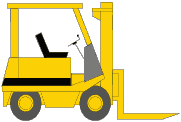Compact truck size
Engine-powered, counterbalanced forklifts are the most widely used type of industrial truck in
the marketplace today. Solid cushion-tired trucks are ideal for indoor use, while pneumatic-tired trucks can be
used for outdoor or indoor applications. They offer several advantages:
An internal-combustion engine can produce more than enough power to continually handle heavy
loads, accelerate quickly, climb grades under full load, and maintain high travel and lift speeds.
Optimum Series forklifts can be powered by gasoline, LP-gas, CNG (compressed natural gas), or
diesel fuels. They can also be refueled, and back in service quickly, to maximize productivity.
Plus, engine-powered forklifts have the power to handle accessories and attachments to meet specific
material handling requirements.
Recent technological advances are enabling electric-powered lift trucks to undertake
applications that in the past were reserved for engine-powered models.
Transistorized motor controllers are producing more efficient power management than ever before.
The result? Longer work cycles between charges, and improved travel and lift/lower speeds.
Onboard diagnostics simplify maintenance work.
Service technicians can forget about time-consuming guesswork. Today's most advanced diagnostics
not only pinpoint trouble, but display potential problems for preventive maintenance before unscheduled downtime
occurs.
While electric-powered counterbalanced forklifts have long been the choice for less stringent
applications, an increasing number of fleet managers are now selecting electric-powered trucks for tough, high-throughput,
round-the-clock applications.
Compared with the previous generation of electrics, today's electric-powered trucks often run
faster, and work harder and longer. Their new capabilities include:
Improved power management and conservation
Many of these changes are a reflection of the advances that have been made in electronics, especially
in the area of motor controllers.
Electric-powered forklifts offer other advantages as well. For example, although an electric-powered
forklift generally will carry a higher initial price tag than an engine-powered truck of the same load capacity,
electrics are extremely economical to operate. In terms of life cycle cost, the electric can cost substantially
less to run and to maintain.
Electric-powered trucks are also both clean-running and quiet -- important considerations given
today's increased environmental concerns.
Narrow-aisle trucks permit the designers of warehouses and distribution centers
to tighten the distance between racks. The result is more pallet storage locations per
square foot.
In a conventional rack configuration, sit-down counterbalanced forklifts handle pallet put-away
and retrieval. The longer wheelbase on this type of truck translates into a wider turning radius, and that in turn
means more maneuvering distance between the racks -- typically about 12 feet.
With narrow-aisle trucks, that distance can be narrowed to 96 inches. The number of pallet positions
is increased by about 50%. In addition, most narrow-aisle trucks can stack at five levels (with minimum downrating).
Let's look at these differences in terms of the number of square feet of warehouse that's required
to store a given number of pallets. A good rule-of-thumb says that in a conventional rack configuration, you'll
need 10,000 square feet of floor space to store 1,000 pallets. Switch to narrow-aisle trucks, squeeze those racks
closer together, increase the height of the racks to five levels, and you'll be able to store the same 1,000 pallets
in just 6,470 square feet. The difference is in the trucks.
There are two main types of narrow-aisle trucks: reach trucks and order-selector trucks. Reach
trucks store pallet loads in the racks and also retrieve pallets when needed. Order-selector trucks lift the operator
up to the height of the pallet load in order to pick individual items for an order.
In some applications, a third type of truck -- the straddle stacker -- handles the pallet put-away
and retrieval work.
Powered pallet trucks are a good choice for industrial applications that call
for moving pallet loads over short-to-medium distances, loading and unloading trailers
and freight cars, working in congested or cramped areas, and economic cost of operation.
For jobs that involve moving loads short distances (up to 100 feet), a walkie pallet truck is
the right one to select. As the distance increases (up to about 400 feet), a walkie/rider pallet truck will get
the job done.
Walkies are often used for loading and unloading pallets in confined spaces such as trailers
and freight cars, and in congested areas such as loading docks. Because they require a very modest investment to
acquire, walkies are also used to provide back-up load-handling capacity during periods of peak activity.
Walkie/rider trucks are offered in several configurations depending on where the operator stands
while the truck is underway. The two most common designs are end-control and center-control.
Both walkie and walkie/rider powered pallet trucks offer a highly economical alternative to using
conventional counterbalanced forklifts for load handling that does not involve stacking.
 BE SURE TO VISIT THE HOME PAGE FOR INFORMATION ON LIFT TRUCKS REPAIR, SERVICE, TROUBLESHOOTING,
AND EVERYTHING YOU NEED TO KNOW ABOUT FORKLIFTS AND THEIR USE.
BE SURE TO VISIT THE HOME PAGE FOR INFORMATION ON LIFT TRUCKS REPAIR, SERVICE, TROUBLESHOOTING,
AND EVERYTHING YOU NEED TO KNOW ABOUT FORKLIFTS AND THEIR USE.
 --BACK TO
HOME PAGE.
--BACK TO
HOME PAGE.

